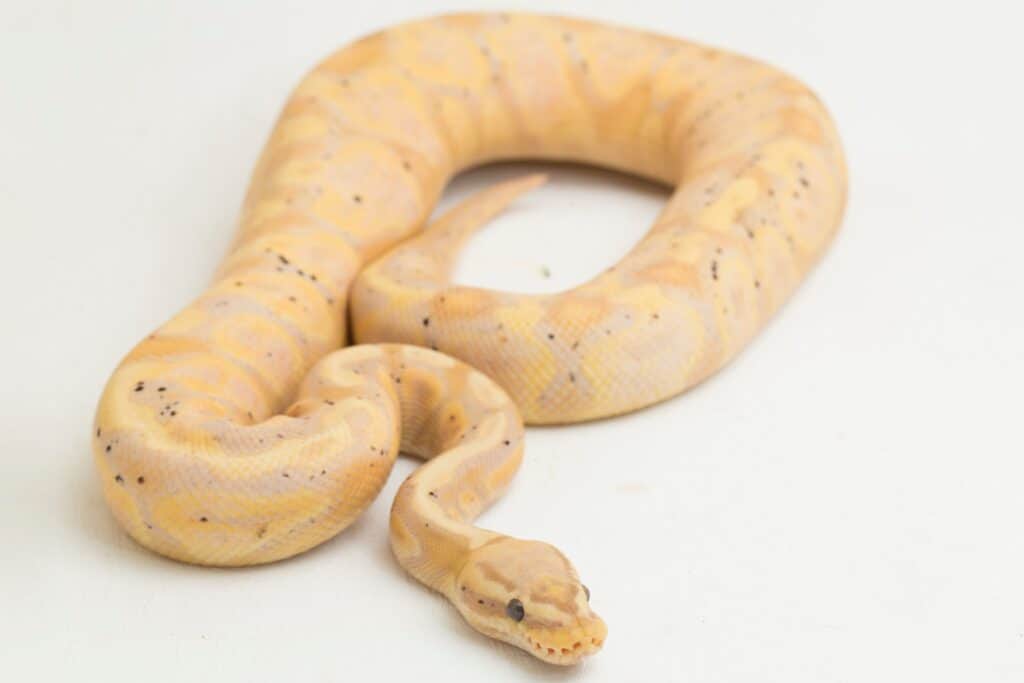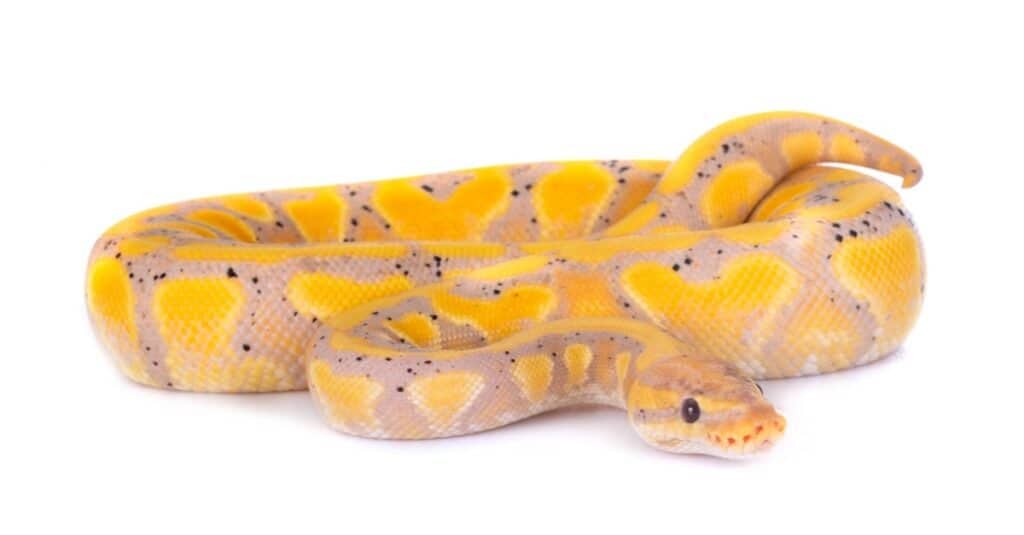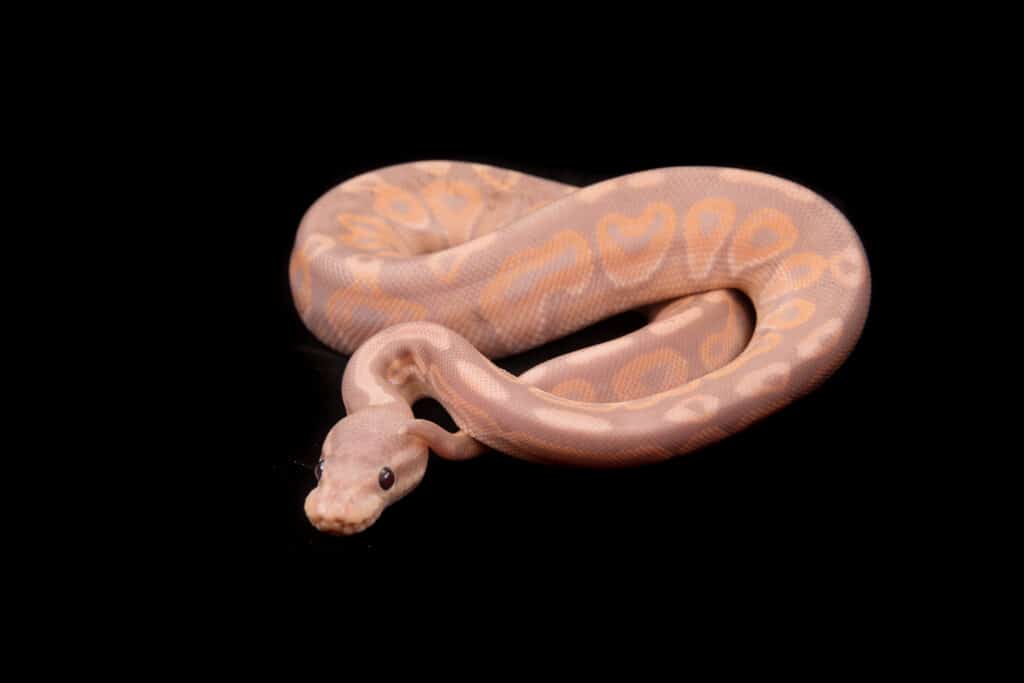Banana Ball Python
Python regius
Advertisement
Banana Ball Python Scientific Classification
- Kingdom
- Animalia
- Phylum
- Chordata
- Class
- Reptilia
- Order
- Squamata
- Family
- Pythonidae
- Genus
- Python
- Scientific Name
- Python regius
Read our Complete Guide to Classification of Animals.
Banana Ball Python Conservation Status
Banana Ball Python Facts
View all of the Banana Ball Python images!
“Banana ball pythons are one of the easiest pet snakes to care for.”
Ball pythons are one of the most popular choices of pets for snake enthusiasts and for breeders — a fact underscored by the fact that there are over 4,000 morphs of the species. And while the bright yellow banana ball python didn’t emerge in the public imagination until 2003, it’s quickly become one of the most popular morphs in a species that’s already produced several different variants in the time since. And since their unique coloration and patterns are the result of a co-dominant genetic expression, they can be reliably produced without any major risk of health issues of inbreeding. Though their light yellow and dark coloring might not make them particularly effective camouflaged hunters anywhere in the world, their mellow personalities make them a highly regarded choice for a cold-blooded companion.
Three Incredible Banana Ball Python Facts!
- The first baby snake born of this morph ended up selling for $25,000, but you can sometimes find banana ball pythons today for less than $100.
- With selective genetics, a rare few baby pythons can be born as super banana ball pythons. This is a great choice for breeders looking to maintain the dominant gene, but super banana ball pythons also don’t develop freckles as they age.
- More than a dozen different morphs have branched off from the initial banana ball python standard, with some of the more colorfully named including the banana spider, banana clown, and black pastel banana.

Where To Find Them
The vibrant coloration of the banana ball python was only achieved by tireless experimentation breeding together different colored morphs of the ball python — and the first banana ball python wasn’t even bred in captivity until 2006. In the wild, members of the species with the same banana coloration are far more rare but not unheard of. Despite that, these variations of the ball python aren’t functionally any different than other pythons in the wild apart from their distinct colors. Ball pythons are traditionally found in west and central Africa as part of the tropical Sub Saharan ecosystem. Habitats for ball pythons can be found in Cameroon, Senegal, Ghana, Chad, Sudan, and Uganda. The Nile River serves as a rough territorial line for ball python habitats.
It’s not by accident that ball pythons have naturally gravitated towards open forests and grasslands. Their mottled coloration and patterns and natural mix of brown and green colorations allow them to blend in easily with brush and shrubs, and the rectilinear motion that pythons employ allows them to move largely unnoticed by prey and predators when under adequate cover. A banana ball python’s bright colors might be a liability to predators in the wild, but owners still need to think about its native location when creating a home for their snake. Humidity needs to be regulated at 50 to 70 percent humidity, and alternating warm and cool spots in the tank help simulate the natural basking locations these snakes would otherwise find within their natural habitats.

In the wild, members of the species with the same banana coloration are far more rare but not unheard of.
©pelsopython/Shutterstock.com
Scientific name
Python regius is one of the more straightforward scientific names for snakes. The python family refers to a broad range of different nonvenomous constrictor snakes spread throughout Asia, Africa, and Australia. Regius is derived from the root word for king and is based on the once-popular rumor that Egypt’s Queen Cleopatra used a ball python as a bracelet.
Population and Conservation Status
As a designer morph created by breeders, the banana ball python actually wouldn’t exist without human intervention. As one of the more popular morphs of one of the most popular pet snake breeds, adult bananas aren’t just common; they can also be picked up for a reasonable price. Ball pythons are considered, by the IUCN Red List, to be of least concern, and there is no tracking for the population numbers of specific snake morphs. Their population may not currently be at risk, but ball pythons are poached for skin and the pet trade. That’s especially true of rare morphs.

The banana ball python is a designer morph created by humans.
©dwi putra stock/Shutterstock.com
Appearance and Description
The easiest point of identification for a banana ball python is its coloration. Their body can range from a basic tan to a more ethereal lilac, but it’s the bright yellow spots that truly help the banana ball python stand apart from other morphs. Albino ball pythons often have similar coloration to banana balls, but knowing the basic facts about these snakes can help you with identification.
Albino pythons have bright red eyes, while banana ball pythons have darker eyes. In terms of physiology, there are no distinguishable differences between the design of the banana morph or a standard ball python. They’re thicker than many other snake species, and their heads are notably triangular with fangs that curve backward. Females are slightly larger than males. Ball pythons get their name from perhaps their most distinguishing feature: their habit of retreating into a ball when they feel threatened.
Look for the following features when trying to identify a banana morph of the ball python:
- A stout body roughly four to five feet long.
- A triangular head with backward-facing fangs.
- Tan or brown body with brilliant yellow splotches.
- Dark brown rather than bright red eyes.

©iStock.com/cynoclub
History and Evolution
Just like other snake species of snakes, the python’s predecessors were also reptiles but with legs. These animals were more aquatic-based. Snakes either lost their legs or became vestigial, as they became more and more unused. It is interesting to imagine animals evolving to have legs and then evolving to lose them! As these snakes adapted to living as low to the ground as they can to avoid enemies and be closer to their prey.
Pythons were previously classified with boas, but modern research has shown that the pythons and boas are separate species due to convergent evolution in different parts of the world, much like monkeys evolved differently in Africa and South America while having shared ancestors. Some of the major differences are that boas give birth to live young, and pythons lay eggs. Pythons also have their heat-sensing pits on their labial scales, and boas have them in between their labial scales.
As this particular type of python is a morph of the normal ball python, the vast majority of them that you might see are specifically bred to achieve their beautiful look; however, they do exist in the wild naturally!
Venom: How Dangerous Are They?
Ball pythons are like all other python species in that they produce no venom. And not only are they unlikely to bite you, but they aren’t inclined to cause too much trouble if they do. Their teeth are sharp, but they can’t cut particularly deep — and the weak jaws of this snake can’t do much serious harm to humans.

Banana ball pythons are not venomous.
©Sanne Romijn Fotografie/Shutterstock.com
Behavior and Humans
Exhaustive breeding led to the creation of the banana ball python, but the species as a whole became popular as a pet for a reason — their relatively high docility. These snakes are shy and bite rarely, and they’re known for having a particularly chill personality. Neither anxious nor curious, these pet snakes will generally just hang out most of the time. Just be careful if they withdraw into a ball, as this is a defensive sign. They could attack if you continue to provoke them.
View all 284 animals that start with BBanana Ball Python FAQs (Frequently Asked Questions)
Are banana ball pythons venomous?
No. Not only are ball pythons not venomous, but they have a relatively weak bite.
How do banana ball pythons hunt?
Like all other pythons, these reptiles are constrictors and ambush predators that sneak up on their prey and then tighten their coils around them to strangle it of its blood supply.
Are banana ball pythons aggressive?
Ball pythons are neither aggressive nor prone to biting, and these facts have made this snake a popular choice as a pet.
Where do banana ball pythons live?
Ball pythons originally hail from West Africa, and a pair of adult ball pythons with similar colors and potentially similar genetics to the banana morph were discovered there in the 1990s. But banana and super banana ball pythons are completely an invention of breeders.
What do banana ball pythons eat?
Both wild and domesticated banana morphs feast on a diet of rodents. And while this diet sometimes includes birds and small reptiles as well, the majority of the meals over a wild python’s lifespan will be just rats. In domestication, prey like gerbils and hamsters can be added to the menu along with other potential snacks.
How much are banana ball pythons?
The price of a banana python is typically between 100 and 200 dollars. You can expect this price to escalate to $600 or more if you’re looking for a rarer super banana ball python.
Do banana ball pythons bite?
Throughout their lifespan, ball pythons would generally rather hide than bite. Identification of a flustered ball python is easy because they tighten into a ball at their current location. Continuing to antagonize them at this point is the easiest way to get bitten.
Do banana ball pythons have issues?
Ball pythons are generally healthy snakes, though they require some specific considerations in terms of temperature and humidity.
What pairs well with a banana ball python?
Ball pythons are mellow reptiles, but they aren’t especially sociable. It’s generally not recommended to put them in cages with other snakes. If you do insist on bringing a friend for them, females of the same species are probably the best choice for this reptile.
Why does my banana ball python have red eyes?
If your ball python has red eyes, it may be an albino. This is a trait that normally doesn’t appear in ball morphs, but it’s a common result of missing pigmentation that occurs as a result of albinism.
How big does a banana ball python get?
The size of a ball python varies depending on their gender. Adult females can reach a length of five feet, while males are more likely to only extend to a size of three feet. The size of a baby python is about 10 inches.
Why does a banana ball python have black spots?
Freckles often develop in banana ball pythons simply as an effect of aging. One way to prevent this is by breeding super banana ball pythons. Their markings remain unblemished over time because they carry two copies of the genetics for the dominant coloration.
How do I care for a banana ball python?
A banana ball python needs the same care that any ball python does. Enclosures should be a foot by a foot and a half by three feet to comfortably give your new pet the space it needs to thrive. Be sure to do some deeper research into the needs of ball pythons before deciding to take on the responsibility of one.
Thank you for reading! Have some feedback for us? Contact the AZ Animals editorial team.
Sources
- ITIS / Accessed February 1, 2022
- Pet Comments / Accessed February 1, 2022
- Reptile Range / Accessed February 1, 2022
- Animal Diversity Web / Accessed February 1, 2022
- Utah's Hogle Zoo (1970) https://www.hoglezoo.org/meet_our_animals/animal_finder/ball_python/#:~:text=These%20are%20small%2C%20heavy%2Dbodied,%2C%20left%20from%20evolutionary%20adjustments). Jump to top / Accessed February 1, 2022


















